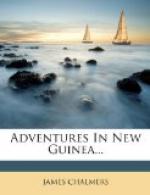3_rd_.—We left Makipili this morning at eight o’clock, and came along leisurely, arriving at Chokinumu at half-past ten. The chief and his wife who accompanied us pressed us to stay a night in their village, and, seeing it would displease them if we went on, we consented. We had a thorough downpour of rain in the afternoon, after a very hot sun, the thunder rolling all round us. The chief Lohiamalaka and his wife are exceedingly kind and attentive; they have kept close by us since we left here on Monday. I am sorry for the Makipili people; they are so afraid of Sogeri, that they have left their houses, and are living in the bush and under the shelter of rocks. Sogeri, Makipili says, will listen to no conditions of peace. Several overtures have been made, but all are useless. We were told at several places that if we ventured to Makipili we should never return; but we have been there, were treated kindly, and pressed to return.
4_th_.—Using our blankets yesterday as a flag for our tent, they got so wet that it required a day to dry them, so we decided to remain here and visit the Laroki Falls. Ten days ago, we found from the natives that they were near here. The native name is Round. We found the falls in a deep gorge formed by the west end of Astrolabe and east end of Vetura Range. On each side of the gorge the mountains run sharp down, in many places precipitous rocks. The falls are E. from Port Moresby, E.S.E. from Moumili, and S.E. from Vetura proper. They are grand, and well worth seeing. I wish we had seen them from below. For a long distance up there are small falls and rapids. The water comes surging on, and then takes a fearful leap of many hundred feet on to a ledge, and from there to the boiling cauldron below. The noise is deafening. Where we stood, nearly level with the water, it was 1340 feet above sea-level, and I do not think that from there to the cauldron could be less than 900 feet. I think it may be possible to get to them from the north side by Mangara, and then we can rightly tell the height of the falls.
5_th_.—Left Chokinumu this morning at eight, and had a pleasant walk for three hours, ascending gradually the Astrolabe until we reached the summit at the back of Tupuselei, 2300 feet high. We were resting before descending, when a native party appeared and approached us, somewhat scared. They said on coming up they heard the noise as of chopping wood (we were marking trees). They came on, and saw through the bush a white man, and at once went back; then, hearing as if natives were with him speaking in Koiari, they returned and determined to meet. They were much pleased at receiving a present of salt. We descended on the west side of the Astrolabe; the descent, being steep and difficult, took us some time. In the afternoon we arrived at Janara, near to Efari, at the back of Pyramid Point, the Astrolabe bearing north. Our friend Lohiamalaka,




